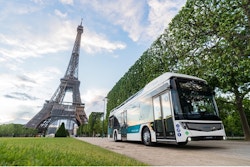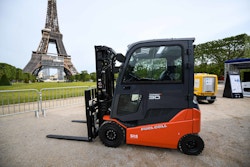Hydrogen, the accelerator of decarbonised heavy mobility
There is no doubt that hydrogen is one of the first realistic solutions for achieving carbon neutrality. Many countries are betting on ambitious development strategies in this energy vector. France, for its part, has committed to supporting the development of the green hydrogen sector* up to 7.2 billion euros by 2030. One of the priorities of this recovery plan concerns heavy mobility.
Heavy mobility, a heavyweight in greenhouse gas emissions
Whether it is rail, sea or air, heavy mobility remains one of the greatest challenges of the energy transition today. Let's take the example of heavy goods vehicles and freight transport. In France, although they represent less than 2% of the total vehicle fleet, they are responsible for more than 22% of CO2 emissions in the transport sector (Source: CITEPA, Secten 2020 format inventory).
Despite significant progress in terms of innovative technologies and compliance with environmental standards by manufacturers and transporters, heavy mobility remains a sector where emissions are steadily increasing, especially since the COVID-19 pandemic, which has considerably boosted e-commerce and home deliveries. These services are becoming increasingly fast, causing many vehicles to hit the road without even reaching their optimal loading capacity. As the best energy is the one that is not unnecessarily consumed, it is important to think globally about the future of the transport ecosystems, from the distributor to the consumer, as technology only progresses!
Trucks that run on hydrogen
What are the main advantages of hydrogen for large vehicles?
The weight of the tanks and therefore the range, an insoluble weak point of vehicles with simple batteries, but also the speed of filling, a key point in any logistics solution. In concrete terms, the operating mode is similar to that of an electric vehicle, silent, clean and with a high torque, without the constraints of weight or recharging time. The power needed to propel a 38-ton truck for hundreds of kilometers requires such a large energy reserve that the weight of the batteries becomes a considerable burden. This vicious circle - more energy requiring more batteries and therefore more weight requiring more energy - can only be broken today by hydrogen storage. The batteries are then limited to short-term storage and energy recovery during braking, and therefore of reasonable weight. This is the architecture used on Energy Observer, which stores up to ten times more energy in its hydrogen tanks than in its Li-Ion batteries, for the same weight!
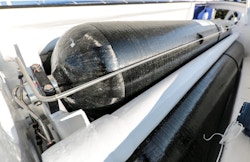
Hydrogen tanks
Hydrogen applications do not only concern propulsion, but also the power supply of the cold chain, which is fundamental in the transport of fresh products.
Take for example the operation of the semi-trailer developed by CHEREAU, the Hydrogen Power H2.
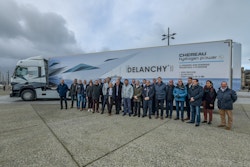
“We find hydrogen tanks, implanted in the chassis between the longitudinal members, one or more fuel cells and buffer batteries. The vehicles are designed for at least two days of long-distance autonomy and one day of distribution. They can be refuelled in only 10 minutes. The tests initiated have made it possible to verify the performance of this clean solution and also to make an initial estimate of the long-term cost of use, which is sufficiently relevant to initiate its industrialisation.”
Although green hydrogen is still in the phase of deploying its production and structuring its ecosystems and distribution, it perfectly meets the demanding needs of heavy vehicles (weight, safety, supply time). It is for this reason that the French plan focuses particularly the development of sufficient infrastructures. If we stay with the example of France, the country plans to equip itself with 100 hydrogen stations by 2023 and between 400 and up to 1000 stations by 2029.
“To achieve success, we need to massify the uses, structure the ecosystems by associating industry and mobility. We need to coordinate national policies with the territories. We need to establish technological partnerships on a French and European scale.”
The current challenge is to develop real ecosystems around heavy transportation, involving vehicle manufacturers, energy suppliers, distribution network developers, and future customers and users. For a coordinated development of all the needs and for an economic model that is feasible.
In France and in Europe, projects are being developed in this direction, in particular to create hydrogen "corridors" to facilitate the development of hydrogen road transport. These projects aim to bring together all the players in this ecosystem with the support of local authorities and funding bodies.
In addition, a recent study by the European consortium FCH JU (Fuel Cells and Hydrogen Joint Undertaking) reveals that hydrogen trucks will be economically profitable by 2027, if production volume targets are met.
This deployment strategy is already well underway in many leading industrial countries. During its stopover in California, the Energy Observer crew was able to see the remarkable lead and ambitions of the United States in this sector. It is the first country to have integrated hydrogen and fuel cell technology into its energy policy, even creating a national day dedicated to this energy vector since 2015. Since the first oil crisis in the 1970s, research has accelerated and some states, such as California, have imposed drastic emission reduction standards. Hydrogen is being deployed all along the Californian coastline, with a target of 5 million zero-emission vehicles by 2030, compared to 350,000 today.

Even if the decisions were sometimes difficult to take, all the industrial players in the field of heavy mobility are now resolutely embarking on this hydrogen revolution, followed by companies determined to decarbonize their fleets rapidly, whether in the rail, air, sea or road transport sectors. The technology and the infrastructure are on the way, but once again it is the entire ecosystem that must meet the challenges of decarbonization, right down to the end customer who will sometimes have to accept a slower delivery to optimize the transport of his purchase!
Le Paris de l'H2, a showcase for the heavy mobility of tomorrow
It is in this context that Energy Observer organized an event last May entitled "Le Paris de l'hydrogène". For several days, Energy Observer exhibition village brought together for the very first-time concrete applications of hydrogen mobility and systems, presented by leaders in heavy mobility such as:
- Toyota Motor Europe, which is equipping the first Caetano Bus with a fuel cell identical to that of the Toyota Mirai, a car that has already sold thousands of units. During the Paris Hydrogen Festival, Victorien Erussard and the drivers of Toyota France broke the world record for the range of the new Mirai, reaching 1003 km on a single tank of fuel.
- Toyota Material Handling, which presented its latest hydrogen-powered forklift truck, an essential link in heavy mobility and an essential element for deploying hydrogen distribution in the main logistics centers, on land or in ports.
- The Delanchy Group, which is using Chereau's first Hydrogen Power H2 refrigerated semi-trailer, which can guarantee the cold chain without CO2 or particulate emissions. The Delanchy Group, leader in the transport of fresh produce, is also a pioneer in clean heavy-duty mobility solutions, from small electric trucks to the first hydrogen tractors. Like Energy Observer, the group is currently testing and integrating all technical solutions in order to imagine the best energy mix for transport and logistics. Delanchy has a very diversified fleet of vehicles, recent and up to the best standards, including electric trucks in urban distribution, Chereau hydrogen technology on refrigerated semis, while waiting for the arrival of the first hydrogen tractors.

- Alstom and its Coradia iLint, the first hydrogen-powered regional train, already in commercial service since 2018 in Germany and soon to be operated in Austria, the Netherlands, Sweden and France on non-electrified lines.
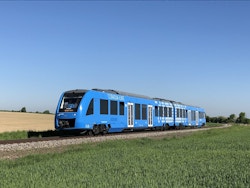
- Airbus, which unveiled never-before-seen images of its future hydrogen-powered aircraft, whose first commercial flights are scheduled for 2035, and which has joined forces with Air Liquide and ADP to develop the airport of the future, is a key player in the hydrogen society and heavy mobility.
To go further:
New projects are expected to emerge in the coming months. Indeed, the Future Energy Coalition, created in 2019 and made up of 14 member companies, is expected to unveil its first seven concrete actions in the following areas: green hydrogen, biofuels, LNG, green electricity, zero-emission vehicles for road, air and sea transport, digital eco-calculation of the transport chain and ecological multimodal platforms. These developments will bring additional resources and human skills to the Coalition, which will help build the sustainable transport and logistics of tomorrow.
*The objective of this plan is to promote the production of green hydrogen (because 96% of hydrogen is currently produced from fossil fuels) but also to reach a scale that will allow this technology to be mass-produced and therefore to generate a drop in production prices until it becomes competitive.
